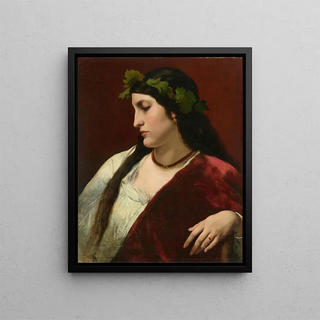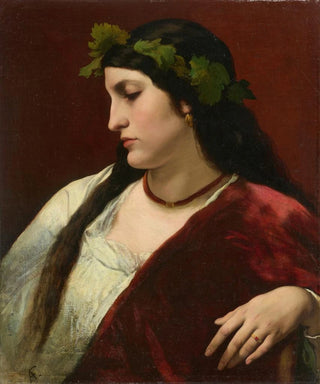Art print | Nanna in Bacchante - Anselm Feuerbach Source: Reproduction | Nanna en bacchante - Anselm Feuerbach


View from behind

Frame (optional)
The artwork "Nanna en bacchante" by Anselm Feuerbach is a masterpiece that evokes the timeless beauty and sensuality of classical art. Painted in the 19th century, this depiction of a female figure, inspired by mythology, embodies the fusion between romantic aesthetics and influences from Antiquity. The scene portrays Nanna, a figure both divine and human, immersed in a world of festivities and celebrations, where wine and dance seem to transcend everyday life. The magic of this piece lies in its ability to capture a fleeting moment of joy and freedom, inviting the viewer to share in this exhilarating experience.
Style and uniqueness of the artwork
Feuerbach's style is distinguished by striking realism, combined with a palette of rich and vibrant colors. In "Nanna en bacchante," the choice of hues evokes warmth and vitality, while the meticulous details of drapery and facial expressions add emotional depth to the composition. Nanna's posture, both graceful and dynamic, illustrates movement and fluidity, characteristic of Feuerbach's art. This piece does not merely depict a mythological figure; it transcends a simple portrait to become a celebration of life and art. Symbolic elements, such as vines and Bacchus's attributes, reinforce the idea of communion between man and nature, while also evoking themes of fertility and rebirth.
The artist and his influence
Anselm Feuerbach, born in 1829, is one of the most emblematic artists of the Romantic movement in Germany. His career is marked by an unceasing quest for harmony between classical tradition and contemporary aspirations. Influenced by masters such as Delacroix and Ingres, Feuerbach developed a personal style that combines the rigor of academicism with Romantic sensitivity. His work had a significant impact on his contemporaries and paved the way for new artistic explorations. By focusing on mythological and historical themes, Feuerbach not only enriched the artistic landscape

Matte finish

View from behind

Frame (optional)
The artwork "Nanna en bacchante" by Anselm Feuerbach is a masterpiece that evokes the timeless beauty and sensuality of classical art. Painted in the 19th century, this depiction of a female figure, inspired by mythology, embodies the fusion between romantic aesthetics and influences from Antiquity. The scene portrays Nanna, a figure both divine and human, immersed in a world of festivities and celebrations, where wine and dance seem to transcend everyday life. The magic of this piece lies in its ability to capture a fleeting moment of joy and freedom, inviting the viewer to share in this exhilarating experience.
Style and uniqueness of the artwork
Feuerbach's style is distinguished by striking realism, combined with a palette of rich and vibrant colors. In "Nanna en bacchante," the choice of hues evokes warmth and vitality, while the meticulous details of drapery and facial expressions add emotional depth to the composition. Nanna's posture, both graceful and dynamic, illustrates movement and fluidity, characteristic of Feuerbach's art. This piece does not merely depict a mythological figure; it transcends a simple portrait to become a celebration of life and art. Symbolic elements, such as vines and Bacchus's attributes, reinforce the idea of communion between man and nature, while also evoking themes of fertility and rebirth.
The artist and his influence
Anselm Feuerbach, born in 1829, is one of the most emblematic artists of the Romantic movement in Germany. His career is marked by an unceasing quest for harmony between classical tradition and contemporary aspirations. Influenced by masters such as Delacroix and Ingres, Feuerbach developed a personal style that combines the rigor of academicism with Romantic sensitivity. His work had a significant impact on his contemporaries and paved the way for new artistic explorations. By focusing on mythological and historical themes, Feuerbach not only enriched the artistic landscape






